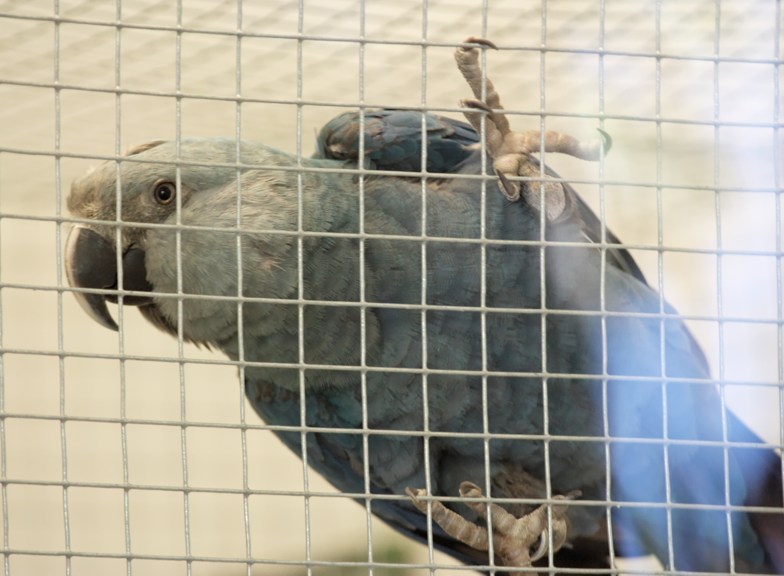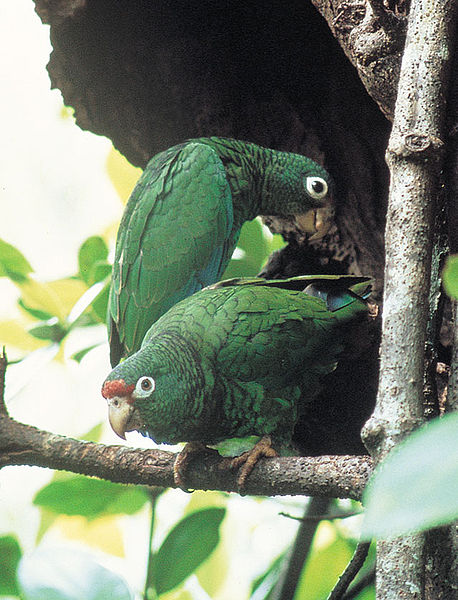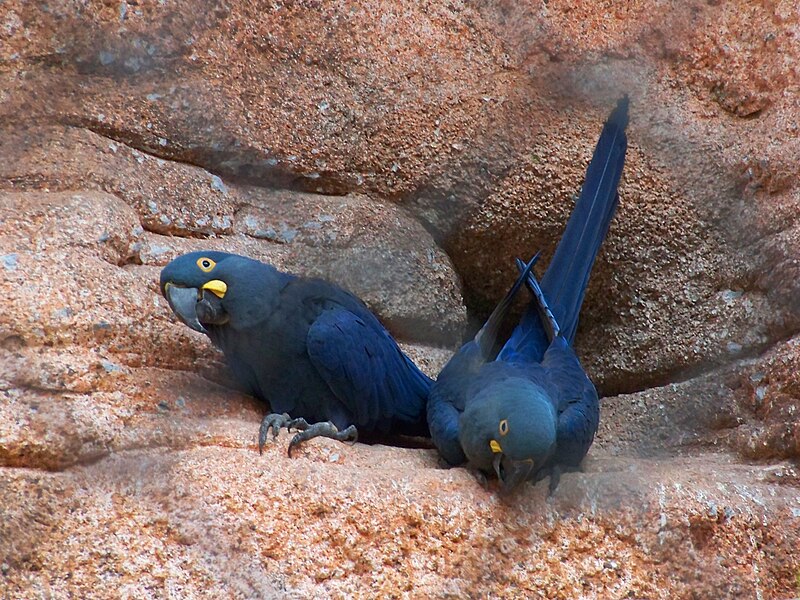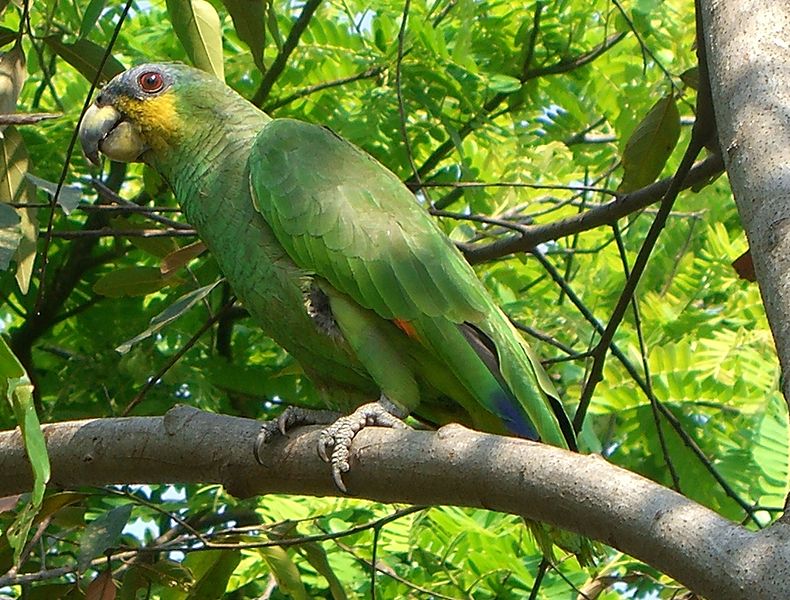
Category Archives: Wild Birds
Feed SubscriptionPlanning for the Spix Macaw’s Return to the Wild
 My experience with reintroduction programs for creatures ranging from spiders to Guam Kingfishers has convinced me that the good intentions of conservationists, standing alone, are never sufficient to ensure any creature’s long-term survival. Conservation must make economic sense to people living in the habitat where the work is being done, and they must also genuinely favor the animal’s return. Today I’d like to highlight a program that is doing an excellent job at laying the groundwork for the return of the Spix Macaw (Cyanopsitta spixii) to Brazil.
My experience with reintroduction programs for creatures ranging from spiders to Guam Kingfishers has convinced me that the good intentions of conservationists, standing alone, are never sufficient to ensure any creature’s long-term survival. Conservation must make economic sense to people living in the habitat where the work is being done, and they must also genuinely favor the animal’s return. Today I’d like to highlight a program that is doing an excellent job at laying the groundwork for the return of the Spix Macaw (Cyanopsitta spixii) to Brazil.
Gone but not Forgotten
Extinct in the wild since 2000 and represented by less than 100 captive individuals, the beautiful blue Spix Macaw is among the rarest of all birds.
Recently, representatives of the group Parrots International visited Curaca, Brazil (Bahia State), the former habitat of this bird, in order to access reintroduction possibilities. A Loro Paraque Foundation project that had been in place in Curaca had been cancelled 4 years prior, but the area’s tiny schoolhouse retained the name given it by local children at that time – The Spix Macaw School.
Children’s Concern Sparks Groups to Donate
Children in the area remained concerned about birds – fearing the researcher’s truck held bird-poachers, 3 youngsters stalked it for several miles in the broiling sun, and spied on its occupants! Moved by the concern evidence by this action, Parrots International supplied the school with the funds it needed to remain in operation (located in one of Brazil’s poorest sectors, it was about to be closed).
Other groups joined the effort, and soon the school was provided with nighttime electricity (to allow for much-needed adult classes), an upgraded toilet and supplies. In order to assist adults in attending evening reading and writing classes, meals are also supplied.
In addition, 4,000 acres of prime Spix Macaw habitat, known as the Gangorra Farm, has been purchased by Parrots International and the Lymington Foundation.
Practical Conservation
This program presents a fine example of an effective strategy – public support for the macaws was obviously strong, but the practicalities of life in a poor, rural area would likely have prevented effective action. By attending to some basic needs of both adults and children, and placing important habitat under private ownership, Parrots International and its partners have set the stage for what may someday be a successful reintroduction program for the magnificent Spix Macaw.
Further Reading
Learn how to help this and other species via donations, purchases or volunteer action here.
Video of Spix Macaw breeding program.
Spixara image referenced from wikipedia and originally posted by Robert01
Parrots of the Caribbean – Saving the Bahaman and Puerto Rican Amazons
 New efforts are underway to help 2 critically endangered Caribbean parrots, the Bahaman Amazon (Amazona leucocephala bahamensis) and the Puerto Rican Amazon (A. vittata). The various Caribbean islands are a hot-bed both of parrot diversity and parrot troubles – the Guadeloupe and Martinique Amazon Parrots, and a subspecies of the Puerto Rican Amazon (formerly found on Culebra Island), are already extinct.
New efforts are underway to help 2 critically endangered Caribbean parrots, the Bahaman Amazon (Amazona leucocephala bahamensis) and the Puerto Rican Amazon (A. vittata). The various Caribbean islands are a hot-bed both of parrot diversity and parrot troubles – the Guadeloupe and Martinique Amazon Parrots, and a subspecies of the Puerto Rican Amazon (formerly found on Culebra Island), are already extinct.
The Bahaman Amazon
The Bahaman Amazon, also known as the Bahama Parrot, is closely related to the Cuban Amazon (please see photo). It is limited in distribution to the Bahaman Islands of Grand Abaco and Grand Inagua. Read More »
Corn for Macaws – a Unique Conservation Plan for the Lear’s Macaw
 With a mere 500 or so individuals remaining in the wild, and very few in captivity, the Lear’s Macaw (Anodorhynchus leari) is one of the world’s scarcest parrots. Yet in its tiny home range of northeastern Bahia State, Brazil, this brilliant indigo-blue macaw poses a serious threat to subsistence corn farmers. Parrots International, in concert with Pro Aves Brazil, the Lymington Foundation and other groups, has devised a most unique initiative that benefits farmers and birds alike.
With a mere 500 or so individuals remaining in the wild, and very few in captivity, the Lear’s Macaw (Anodorhynchus leari) is one of the world’s scarcest parrots. Yet in its tiny home range of northeastern Bahia State, Brazil, this brilliant indigo-blue macaw poses a serious threat to subsistence corn farmers. Parrots International, in concert with Pro Aves Brazil, the Lymington Foundation and other groups, has devised a most unique initiative that benefits farmers and birds alike.
Endangered but Troublesome
It’s easy for folks living in relative financial security to criticize others for killing macaws, but for indigent subsistence farmers in Bahia State, Brazil, the Lear’s Macaw represents a serious threat to survival. The birds pillage the fields of people who, working without the benefit of mechanized equipment and fertilizer, raise barely enough corn to feed their families and livestock. Children are often kept home from school in order to chase the bird, but the enterprising macaws have learned to largely ignore their efforts. Read More »
Parrot Toys – Study Shows Orange-Winged Amazons Have Distinct Preferences
 Toys are more than just “time fillers” for parrots. Social and highly intelligent, pet parrots suffer badly when bored, and soon exhibit destructive behaviors or stress-related illnesses. Zoos are now requiring that toys and foraging opportunities (they call it “Behavioral Enrichment”, sounds better in journals!) be provided to animals ranging from frogs to elephants. A study recently published in Applied Animal Behavior Science (V.120, N.3) has revealed that, at least for Orange-Winged Amazon Parrots (Amazona amazonica, please see photo), all toys are not created equal.
Toys are more than just “time fillers” for parrots. Social and highly intelligent, pet parrots suffer badly when bored, and soon exhibit destructive behaviors or stress-related illnesses. Zoos are now requiring that toys and foraging opportunities (they call it “Behavioral Enrichment”, sounds better in journals!) be provided to animals ranging from frogs to elephants. A study recently published in Applied Animal Behavior Science (V.120, N.3) has revealed that, at least for Orange-Winged Amazon Parrots (Amazona amazonica, please see photo), all toys are not created equal.
Parrot Preferences: What and Why
The study compared the reactions of parrots to wooden toys differing in size, color and harness and to rawhide toys that varied in color. The toys were attached to computer-monitored switches, so that the birds’ reactions would not be influenced by observers, and could be recorded round-the-clock. Read More »
 That Bird Blog – Bird Care and History for Pet Birds
That Bird Blog – Bird Care and History for Pet Birds
